Inquiry Teams Transcript
Teacher: If you wanna compare these, they should both be what? The same, right?
Narrator: It’s really hard for a teacher to take all of the data and information that they’re getting every day and process it alone.
Teacher: How would you do that? Let me ask you that.
Narrator: Not only is an average teacher dealing with 100 to 150 students on a regular basis, but they also have all of this work to look through and not enough time to go through it. By taking time to go small and have other teachers look at student work, look at your lesson plans and give you that space to reflect, it’s huge. It’s essential.
Teacher: Okay. We’re going to conduct the enquiry protocol. Today we’re going to look at target student work for Anna’s class, and we’re going to support her in figuring out what they can and cannot do. Hopefully we’ll come up with some implications for instruction. Following that, Anna’s gonna kind of reflect on that feedback and what she plans to do next for supporting her target students. Then we’re all gonna finish up with our takeaways. We’re gonna give Anna three minutes to kind of provide context for the work we’re looking at and talk about target students Natalie and Chris.
Teacher: This is their homework from last night.
Narrator: On the average, a teacher has about two target students. We look really, really closely to see how that student is moving throughout the year.
Teacher: Yesterday in class, we created histograms based on world literacy data, and I really tried to have them go through an interpret what it meant.
Teacher: The lesson is about having them take histograms to be able to compare data.
Teacher: What does the Y axis represent?
Teacher: Natalie was looking at literacy rates, and Natalie had a really hard time interpreting what the frequencies meant.
Teacher: Was she the only one struggling with that yesterday that you saw, or were there perhaps other students that you either didn’t hear form or you did hear from that exhibited that?
Teacher: Most students are able to verbalize it. They struggled setting up their intervals or finding appropriate intervals, though.
Teacher: One of the things that Zia Mara 02:00 said was let’s change the data set. She actually gave me the idea to look at a different set of statistics.
Teacher: Is there a way to kind of go through maybe an activity like what Emily articulated, where it’s like, okay, so you’re 12 months of the year? Like, why did you make this choice? At the beginning of class, just so that kids are spending time analyzing the interval and seeing where you place it?
Narrator: We’re researchers on this team, and we’re really interrogating the evidence every time we take that time to just look at that student work.
Teacher: Really, having them really try to make a story of this information of this data. I think that’s one of the takeaways, because I think when students look at this, it just becomes more meaningful, like you said.
Teacher: Talk more about what you’re doing today, because then we can provide more targeted responses.
Teacher: One of the things I had is having them do two histograms—
Narrator: It’s always really about anticipating or analyzing student work and making some concrete decisions around that and then seeing how are we going to measure that growth?
Teacher: I’m just thinking. Re-teaching this, I would put names down here first, so that, just so they capture what frequency means, and then put in numbers. Cuz I didn’t even realize like how confusing that can be.
Narrator: They all are bringing something unique, like Emily’s taught frequency histograms, so she’s contributing, “Oh, yeah, like this was a mistake that I observed,” and now she walks away with something that she was gonna do with her students because she realized there still was an issue. She’s gonna go back and deal with it now.
Teacher: Anna, you get the last minute of takeaway.
Teacher: For me, this just means that for today’s activity I really need to make sure that I actually go through and highlight scales and interval and labeling that they still needed help with a little bit of the basic stuff.
Teacher: I’m gonna say choose appropriate intervals.
Narrator: Anna realized that there were some strategies she could take back, and some of the little things that the students were making mistakes on, like not putting the interval in the right place, helped her see that might be the reason why Natalie was actually having trouble making sense of her graph in class. She used that today to change her instruction.
Teacher: We’re gonna look at Natalie’s first two histograms. Let’s start off with what did Natalie do right on these histograms?
Narrator: What she’s doing in her classroom is a microcosm of what we want teachers to be doing across the board. Her whole classroom became an enquiry team, so we have this parallel structure. She’s holding her students to that standard, there’s no reason why she shouldn’t be held to that standard.
Teacher: Next week, Melissa, you’re slated to present.
Teacher: Being able to work with other teachers, bounce off other ideas, it’s just really helped me figure out how to actually get more in-depth and to get the kids to understand and explore.
[End of Audio]

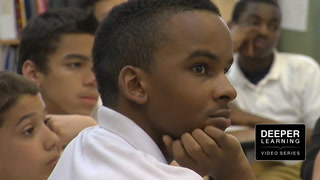
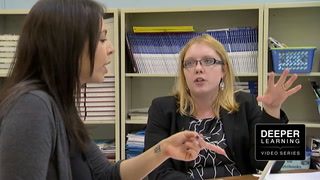
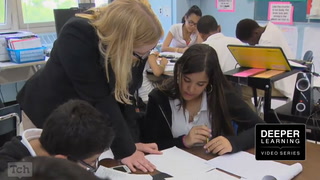
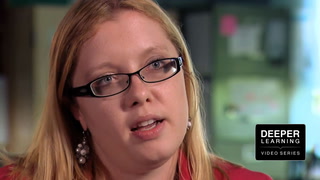
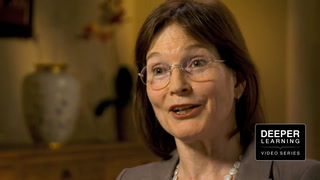








2 Comments
Tracy Vining Mar 19, 2020 2:16pm
1. The stragies that emerge from the inquiry team to help Ms. Tabor was to change the intervals to make better understanding.
2. What Xiomara Gonzalez means by "go small' is to look at 2 students work instead of the whole class for understanding.
3. The protocol for conducting an inquiry team is to have time limits and share out.
Tracy Vining Mar 20, 2020 12:08pm
Wow! This would be amazing... Still trying to imagine finding the time to do this... But great to see an example of how this looks.